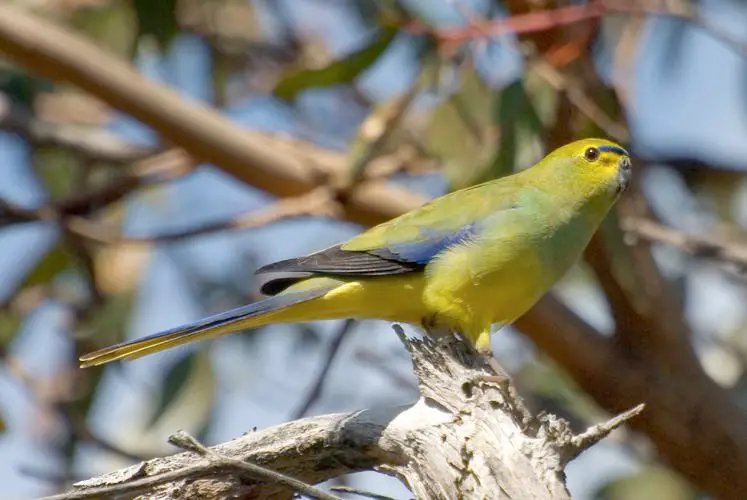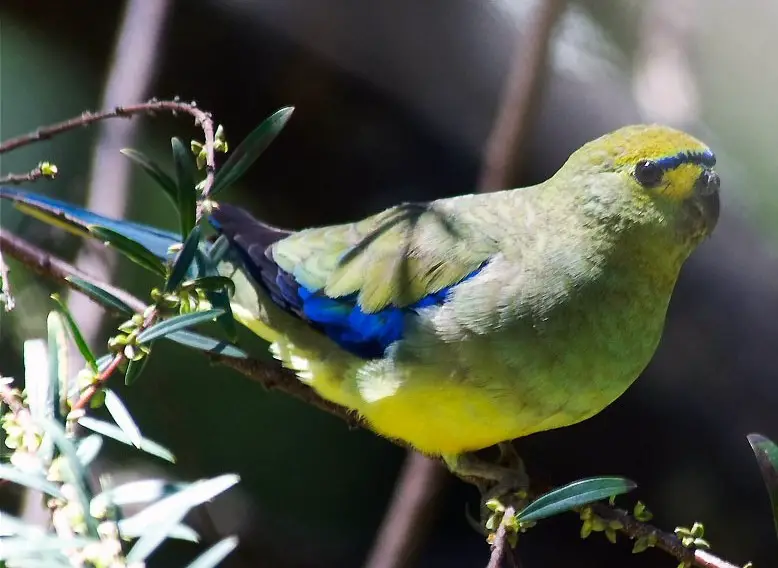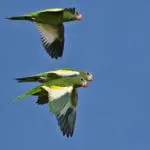Scientific Facts
| Common Name | Blue-winged Grass-Parakeet, Blue-banded Parrot Grass-Parakeet, Grass Parrot, Hobart Ground Parrot |
| Scientific Name | Neophema chrysostoma |
| Size | 21cm (8.2 in) |
| Life Span | 10-15 yrs |
| Habitat | -a varied range of habitats including savanna woodland, grasslands -orchards, forest clearings, farmland, coastal marshland -dune systems, heath, saltbush, mallee, mulga, and other open areas. |
| Country of Origin | Australia |

If you’re seeking a new plumed buddy that will present you to a blizzard of pleasure, then seek no other than the Blue Winged parrot. These small and forever adorable birds will unlock up an entirely new aspect of pet parrots and your bond with them. Blue Winged Parrotlets are tiny, cuddly, easy to heed for, and amazingly entertaining. By all means, these little plumed dopes will be a darling in the home in a minute. Don’t be deceived by their small stature – they are plentiful of spirit and can be pretty naughty.
Physical Description
The initial matter you’ll learn to regard is how small these birds indeed are. The pet name“pouch parrots” clearly seems sensible. The parrot family of birds is extremely intimately linked, and there is a minute to no distinctions in overall physical presence. The grown-ups attain a standard measure of merely 12 centimeters (5 inches) and scale only 28 grams (1 ounce) on a standard. These symbols are rare and might give distinctive features as opposed to other, larger parrot. However, training is essential, and a spacious enclosure (concerning the bird’s measurement) is a requirement.
The Blue-Winged parrotlet’s title is a small bonus, though despite– these are some charming and good-looking birds. Whereas the colors are few and simple, and somewhat comparable to other parrotlet strains, their bizarre features cause them to attract attention and allure with their pure luxurious markings. The body is almost undividedly pale green, with the rear duller, and the front significantly paler. The appendages have some dark blue flight plumes and tiny spots on top. This is a generatively dimorphic strain, and the females possess no blue pigments. This matter gives them quickly mixed with the Green Rumped parrotlet. Anyway, if you’re attending for an easy and attractive bird without various features, then these little treasures are merely the appropriate decision.
Geographical Range
Particularly in eastern and the midlands areas of Tasmania and the southern Victorias, the major distributions of Blue-winged Parrots are Victoria and Tasmania. More scattered populations are observed in western New South Wales and eastern South Australia, spreading to south-west Queensland and periodically toward the Northern Habitat.
Habitat
The Blue-winged Parrot occupies a variety of environments from inland, coastal, and sub-coastal areas, far and wide to semi-dry regions. Across their area, they prefer meadows and grassy forests. They are frequently seen near marshlands, both near the shore and in semi-dry regions. Blue-winged Parrots can likewise be observed in modified conditions such as golf-courses, paddocks, and airfields.
Common Behavior
The Blue-Winged Parrot is the ideal pet parrot on such countless degrees. Their caring and pleasant nature have features to satisfy every master. They can be considerably giddy and naughty small travelers, and they won’t falter to cuddle up to you on the couch or examine the area beneath the covers. They likewise love grazes and snuggles. And this excellent blend of assertive qualities gives these parrots a favorite pet with young people and singles. They also obtain their proper spot in household environments, presenting their humorous facade to the whole family. Be it as it may, a Blue Winged parrot is beyond just a pet – it’s a companion and an artist.
Speech and Sounds
Great news for the entire resident people. The cry degrees are remarkably faint when it gets to parrots, recognition to their extent for the most portions. Blue Winged Parrotlets possess shrill, penetrating direct cries, though the decibel utterly isn’t extremely sharp. They might imitate some of the plain terms in a whined and cartoonish tone, presenting it a fresh shot of comedy. This might appear not too entertaining, but believe it or not, a Blue Winged parrot will unmistakably discover other approaches to produce a bunch of fun into your residence.
Diet and Feeding Habits
In the wildlife, the native diets of the Blue-winged parrot are grains from herbaceous plants and grasses. Periodically accessible fruits, fruit and flower buds, blossoms, and various vegetable and plant material balance the dietary consumption. Bugs may constitute a portion of their regular food consumption.
In the aviary, these birds need a standard “budgie seed mix” or “small parrot mix” enhanced with traditional canary grain and a little quantity of sunflower seed. Lawn grasses along with a few leafy green legumes such as endive, silverbeet, or spinach. A variety of fruits, e.g., orange, apple, pear, and a variety of periodically accessible vegetables, must be administered as an element of their regular food absorption. Germinated or softened seeds can be given.
Some birds will devour bugs such as mealworms, particularly if they produce juveniles in the cradle. A beetle, larvae, and mealworm larvae can be provided. The bugs present a great source of efficiently absorbed protein. Neophemas admitted with softbills, finches, or other bug-eating birds will frequently mimic the other inhabitants and consume insects.
Trade parrot kernels may constitute a portion of well-balanced meal consumption.
Reproduction and Life Cycle
Several couples may dwell in a block of the particular wood, creating a breeding territory. Blue-winged Parrots reproduce in southern Victoria, Tasmania, and coastal south-eastern South Australia. They establish monogamous partners and build their dens in a tree stump or hollow, optionally one with a perpendicular crack. The eggs are placed on a layer of decomposed timber. The female solely nurtures the eggs, abandoning the den at periods to be supplied by the male, but both origins serve the fledglings. Clutch 4-6 eggs, nurtured for approximately 18-20 days. Juveniles leave subsequent another month. When picking den places, Blue-winged Parrots strive to obtain one with a little hole that will limit predators, like Grey Shrike-thrushes, taking in to poach the eggs and newborn.
How to Breed
Blue-winged Parrots will promptly utilize cradle crates and woods. Most birds have all preferred cradle crates, and to get anything lightly; separated the woods to create additional scope and to get it more accessible to examine the juvenile while in the crate. These birds will accept budgie or small parrot nest boxes.
The normal reproducing period in Australia is from October – January; however, this will (like most birds) vary on the volume of precipitation and moisture as competently as the existing food rations for their junior. Some have been victorious in breeding the Blue-winged parrots. The female will remain on the eggs while the male nurses the female frequently through mating routines, as typically observed by the male proposing the hen and will somewhat hang his wings, and as if it was a warm day. Gather up and down the wing, and will lift his crown and breast in a forward and upward movement. Experts describe these chest thrusts. The hen will rest on the porch scrutinizing, once she is set to match, she will bend over the roost while her bottom is in a mounted state and anticipate the male. The male may likewise disgorge food straight into the crate access.
Experts have witnessed supplying inside and outside the cradle crates from the male. The female will produce between 3-6 eggs in a clutch, and double conceiving is most prevalent in this strain. The female begins to nurture the eggs from the initial egg-laying. Offsprings will begin to grow out of the cradle at approximately 1 month and occasionally “commonly in budgie boxes” the juvenile may come out of the crate while they are not equipped to navigate. If this occurs, all that is needed is to pull up the juniors and set them back within the cradle crates from where they originated from.
- Get a young couple of birds so they can thrive and link mutually (unrelated pair)
- For most reliable outcomes, have one pair to an aviary to themselves
- Give additional crates with a variety of measurements and in several positions
- Present a healthy dietary menu. With loads of fresh vegetables, fruit, (Some experts supply a lovebird mixture with an intermediate parrot blended for their seed nutrition), arbitrary to produce pelleted meals in a separate serving platter
- Sustain an anxiety-free aviary because too much sound or agitation will generate the hen to not be pleased to retreat
- Sustain a good worming application to better reduce additional dilemmas to the bird’s well-being
Nest box size: Parrot dwelling crates are small-sized covering 5 x 5 x 8 inches. Another substitute measurement that could be adopted is a tiny parrot cradle crate, marking 11” x 7” x 8”. If you employ the budgie nest box, you will not require to supplement any underlayer since the eggs, when produced, will remain collectively in the concaved dent previously created in the bottom of the cradle crate. If you prefer to utilize the tiny parrot den crate, you will need to give a substrate. Some experts commonly utilize traditional potting mixtures without any kind of synthetic additives and grains etc. The potting blends will provide a fine substrate for the female to carve the foundation for her laying eggs.
Pet Care

A spacious enclosure is needed, except the bird is to be let out for extended periods. Several birds can consume most of their course on a parrot roost or playpen. To house their passion for cruising, Blue-winged Macaw couples perform excellently in an outdoor aviary of 108” x 60” x 60” x 72”, with an indoor screen.
In the native, they supply nearby accessible fruits, particularly nuts and blossoms in treetops, palm nut fruits, seeds, and shrubs, as well as hunting in cereal or grain domains. In confinement, they will consume a mixture of commercial pellets, fruits, nuts, and seeds, as well as the equivalent dietary meals humans consume. Blue-winged parrot must be supplied with a broad assortment of food, blended to give sensible nutrition.
When consuming, they will pluck up food in their claws and devour it. They can be quite choosy and occasionally will not consume meals they are tired of.
Activities
They prefer to soar and play. Give loads of playthings. This parrot is very dynamic and requires a place to spread its wings. In-flight, Blue-winged Parrots are pretty inventive, dropping, diving, soaring, and flitting about the aviary. To limit monotony, they should be provided lots of games to play with and grind. Wooden munch playthings are generally a favorite with this breed.
Health and Common Conditions
Small size doesn’t constantly imply weak vitality. Blue Winged Parrots are recognized for their excellent capacity to adjust. Of course, they’ll sense some items much more manageable than larger birds, so take responsibility to guarantee maximum condition (not too scorching and not too freezing), to reduce wind, and to give them a lot of interplays and direct light. These cheerful small birds unquestionably adore and demand to snuggle, playing, and flubbing around. Merely be cautious when they’re outside and about – give particular consideration not to squash them by mishap.
Availability
This bird has been successfully bred in captivity and is occasionally available.
Conservation
- Red list category of the UICN current: Near threatened
- Population trend: Decreasing

The distribution of the Blue-winged Macaw: it is considered that it may be in the zone of 2,500-9,999 exemplars in entirety, which is equivalent to a band between 1,667-6,666 adult exemplars.
A population slump somewhat fast and continual is assumed it may be because of territory destruction, the acquisition for the cage bird enterprise, and the killing as a pest crop.
Its slump is merely partially described by erosion because it has dispersed from regions where have seemingly vanished suitable environments. They suffer from the arrest of the bird industry cage.
To some degree in Argentina, his defeat may have been induced mainly by the killing of the Blue-winged Macaw recognize them annoyances for crops.
FAQs
Where do blue parakeets come from?
Budgerigar: The Parakeet from Australia
Do parakeets like to be held?
While parakeets are bright, loving birds, their impulses tell them to be cautious of humans.
Is it OK to grab your parakeet?
Your finger is a suitable roost for a parakeet. Taking a parakeet in his enclosure isn’t like pulling up a kitty. While your parakeet is probably still obscurely intimidated by your hand, he is at least familiar with it. Put it in gently and secure it in spot for nearly 10 minutes, never pushing your bird to move near it.
How long does it take to tame a parakeet?
This usually gets approximately two weeks. A great indication the budgie is feeling content in its surroundings is how it behaves.
What colors are birds afraid of?
Most bright colors, however, can be utilized to draw various several birds, with specific bird species being more attracted to distinct hues.
What to do if you find a parakeet?
Place the bird in a calm section of your house and embrace the enclosure with a cloth so he’ll calm down.
What smell do birds hate?
A mixture of peppermint oil and citronella is confirmed to secrete a smell that is unpleasant to birds but quite appealing to humans.
Do birds like the color blue?
Bluebirds and bluejays are drawn to the color blue. Goldfinches are dragged to yellow as well, and orioles are attracted to orange. This demonstrates that some species of birds are drawn to the corresponding colors as other birds.


